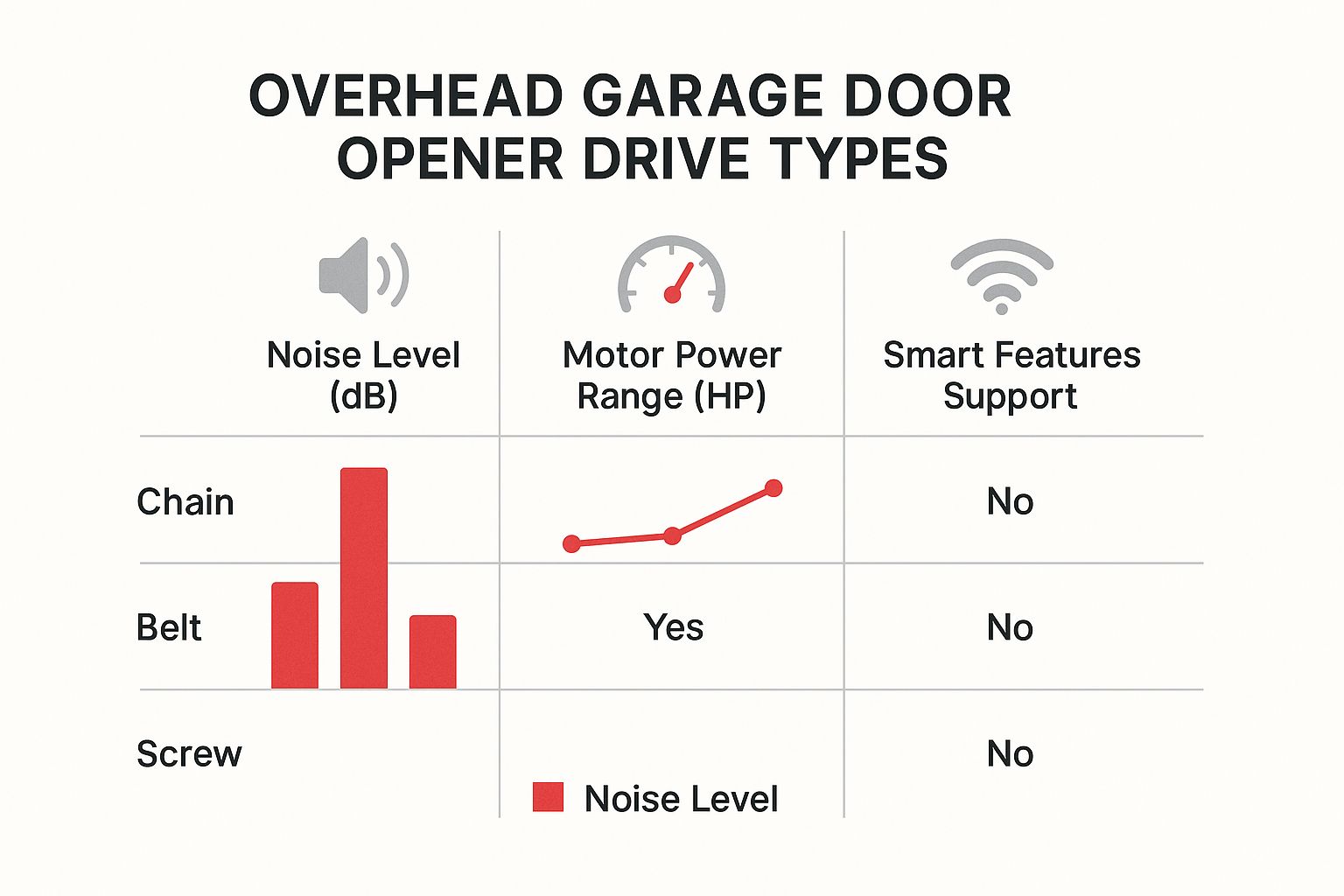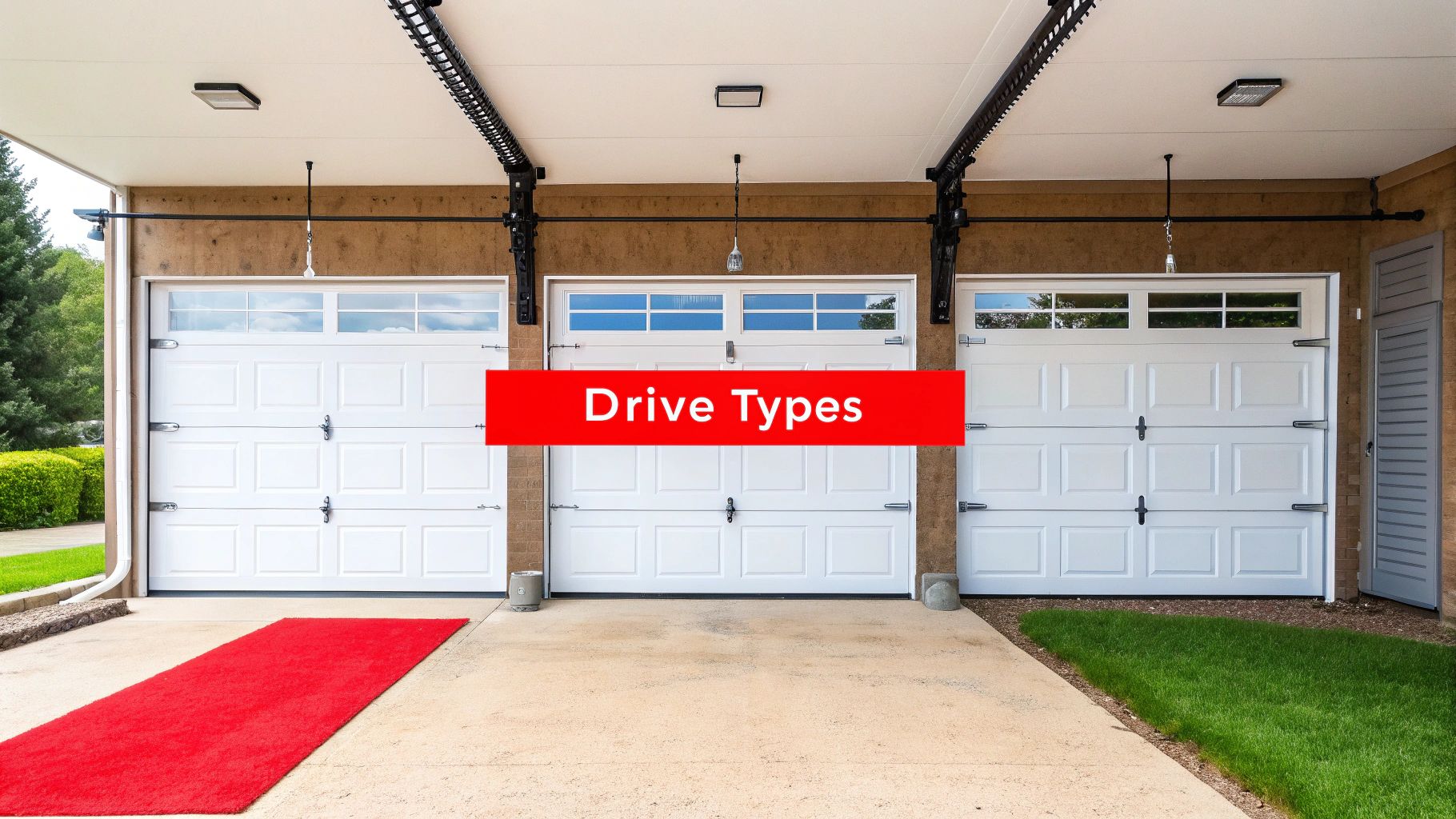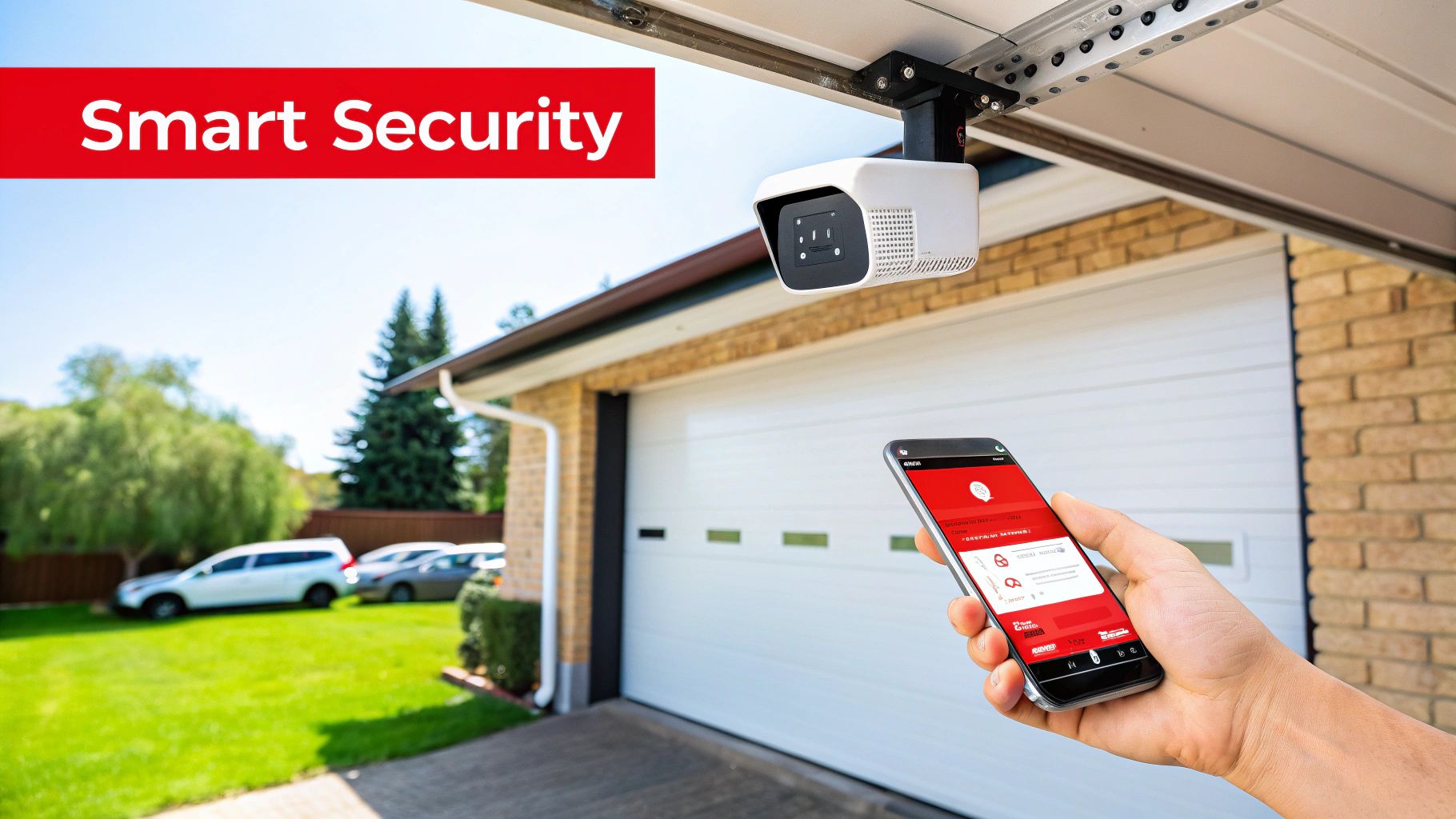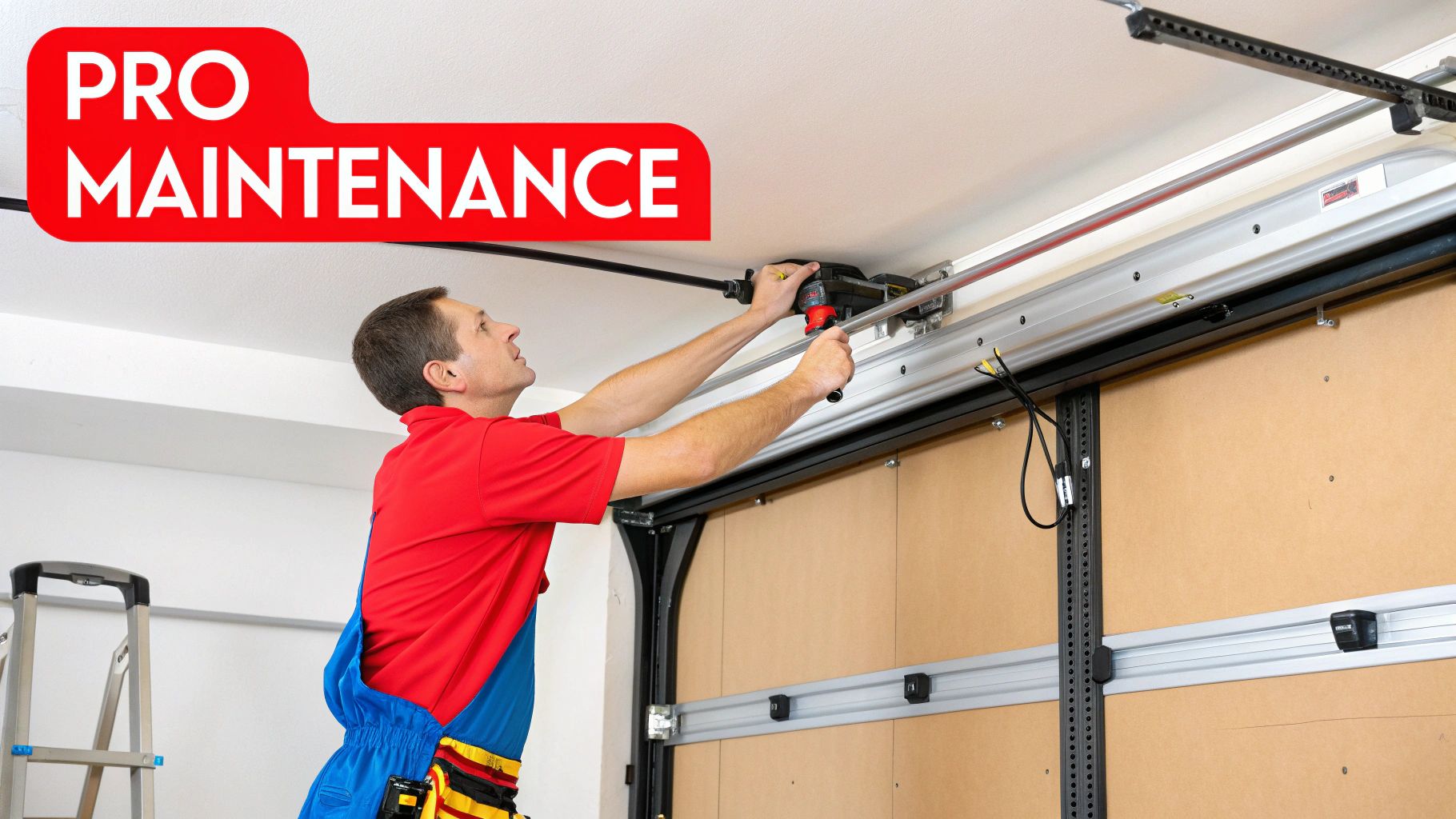Picking the right overhead garage door opener is a critical decision that quietly impacts your daily routine and property security. It’s not just a motor; it’s the command center for the largest moving part of your home or business. A well-chosen opener provides years of smooth, secure, and hassle-free operation, a fact supported by industry data showing that reliability is a top purchasing driver for over 70% of property owners in Texas and Oklahoma.
Choosing Your Ideal Overhead Garage Door Opener
Think of the garage door opener as the brain of your entire garage system. It dictates noise levels, smart home integration, and security against intrusion. For those of us in Texas and Oklahoma, it also means finding a unit that can handle brutal summer heat and continue operating during a storm-induced power outage, a common concern in our region.
The right choice balances three key factors: the drive type (chain, belt, or screw), the horsepower your door requires, and the smart features that fit your lifestyle. A mismatched opener isn't just an annoyance; it can strain the entire system, leading to premature mechanical failures and costly garage door repair.
Comparing Drive Types at a Glance
The drive system is the heart of the opener, dictating performance, durability, and sound output. If you have a bedroom above the garage, your priorities will differ vastly from someone with a detached commercial workshop. Nailing this choice is the most crucial first step.
This infographic breaks down how the three main drive types stack up against each other on crucial factors like noise, power, and smart home compatibility.

As you can see, belt drives are the champions of quiet, making them perfect for attached garages. On the other hand, chain drives deliver rugged, no-nonsense power at a price point that's tough to beat for commercial and detached residential applications.
To help you sort through these options, we've put together a quick summary of the key features to look for.
Overhead Garage Door Opener Features at a Glance
| Feature | What to Look For | Best For |
|---|---|---|
| Motor Power | Measured in Horsepower (HP). 1/2 HP for standard single doors; 3/4 HP or more for heavy, insulated, or oversized doors. | Matching the motor to your door's weight to prevent strain and ensure longevity. |
| Smart Technology | Wi-Fi connectivity, smartphone apps (like myQ), voice control (Alexa, Google Assistant), and delivery integration (Amazon Key). | Homeowners and businesses seeking remote access, monitoring, and integration with a smart ecosystem. |
| Safety Features | Photo-eye sensors (auto-reverse) are mandated by UL 325. Look for rolling code technology to prevent break-ins. | Every property. These are non-negotiable safety standards for protecting people and assets. |
| Battery Backup | An integrated battery that activates during a power outage, allowing continued operation. | Texas and Oklahoma properties in areas with frequent storms or unreliable power grids. |
| Noise Level | Belt drives are whisper-quiet. Chain drives are the loudest. Screw drives fall in the middle. | Homes with living spaces adjacent to or above the garage. |
| Lighting | Integrated LED lighting offers bright, energy-efficient illumination. Some models feature motion-activated lights. | Garages that double as workspaces or require enhanced visibility for safety and convenience. |
This table provides a data-driven starting point for comparing models and zeroing in on what matters most for your property.
Aligning the Opener with Your Door
Ultimately, the best opener is one perfectly matched to your specific door. A heavy, solid wood residential door or a commercial sectional door requires a much stronger motor than a lightweight, single-car aluminum one. If the motor is constantly struggling, it's a recipe for burnout.
An industry best practice, compliant with manufacturer specifications, is ensuring your garage door is properly balanced before selecting an opener. The opener is designed to manage motion, not to lift the dead weight of a door with weak or improperly tensioned springs.
This is why understanding how the door and opener work as a system is so crucial. If you're planning a full upgrade, exploring different residential and commercial garage doors will provide a complete picture. This helps you make a smart investment that boosts your property's function, security, and value.
Understanding Belt, Chain, and Screw Drive Systems

When selecting an overhead garage door opener, the single most impactful decision is choosing the right drive system. This technical detail directly impacts daily life—from the noise heard inside your home to the long-term reliability of the door's operation.
Essentially, the drive is the mechanism that moves a trolley along a rail, which in turn pulls your door open and pushes it shut. The three main types each have distinct performance characteristics. What’s perfect for a detached workshop in Abilene might be entirely wrong for a home in a quiet Denison suburb with a bedroom directly above the garage.
The Workhorse: Chain Drive Openers
The chain drive is the classic, most recognizable type. A heavy-duty chain, similar to one on a bicycle, runs along the rail. This time-tested design is incredibly strong and dependable, making it the go-to for lifting the heaviest custom wood doors or high-cycle commercial doors without issue.
Its main appeal is pure brawn and value. For detached garages, workshops, or commercial settings where noise is not a primary concern, the durability and budget-friendly price of a chain drive are unbeatable. However, the metal-on-metal action makes them the loudest option.
The Quiet Achiever: Belt Drive Openers
A belt drive opener uses a steel-reinforced rubber belt instead of a metal chain. This simple change makes a world of difference, dramatically cutting down on noise and vibration for a smooth, whisper-quiet operation.
This makes belt drives the undisputed winner for homes with attached garages. In fact, industry surveys show that noise reduction is a top priority for over 60% of homeowners during an opener upgrade. It’s no wonder belt drives have become the residential standard. You’ll typically pay more for a belt drive, but for most homeowners in Texas and Oklahoma, the peace and quiet are well worth the investment.
Key Insight: The sound difference between a chain and a belt drive is substantial. A chain drive can transmit vibrations through a home's framing, whereas a quality belt drive is often completely unnoticeable from an adjacent room.
The Low-Maintenance Powerhouse: Screw Drive Openers
Screw drive openers use a long, threaded steel rod that rotates to move the trolley. This design has fewer moving parts than a chain or belt system, which translates to greater durability and less maintenance—a huge plus in the fluctuating climates of Texas and Oklahoma.
They are known for being powerful and fast, often opening a door quicker than other types. While quieter than a chain drive, they can be louder than a belt drive and require periodic lubrication on the screw to maintain smooth operation. For anyone who prioritizes speed and minimal upkeep, a screw drive is a fantastic choice.
Comparison of Garage Door Opener Drive Types
To help you see everything side-by-side, here’s a quick breakdown of how the three main types of overhead garage door openers stack up.
| Drive Type | Noise Level | Cost | Maintenance | Ideal Use Case (TX & OK) |
|---|---|---|---|---|
| Chain Drive | High | Low | Moderate (requires tension checks) | Detached garages, workshops, commercial warehouses, or budget-focused projects. |
| Belt Drive | Very Low | High | Low | Attached garages with living spaces nearby or overhead. |
| Screw Drive | Medium | Medium | Low (requires lubrication) | Homes and businesses needing fast operation and reliability in extreme temperatures. |
Ultimately, the best drive system is the one that fits your property’s layout, your budget, and your operational needs. If you're weighing the options, our experts can help you find the perfect match through our professional garage door opener installation services.
Smart Features and Modern Security: More Than Just a Motor

Today's overhead garage door opener has evolved from a simple motor into a central hub for property access, blending robust security with smart convenience. These are not flashy gadgets; they are practical solutions for modern life in Texas and Oklahoma.
The market reflects this demand. Valued at roughly $2.8 billion in 2023, the global garage door opener industry is projected to hit $4.9 billion by 2032. This growth is fueled by homeowners and businesses demanding smarter, safer ways to manage property access.
Smart Connectivity and Remote Access
The primary game-changer is Wi-Fi connectivity, which transforms your smartphone into a secure, universal remote control for your garage door.
Imagine a critical delivery arriving at your Denison business while you're off-site. Instead of leaving the package exposed, you can open the garage door just enough for the driver to place it safely inside, then securely close it—all from your phone.
Key benefits of a connected opener include:
- Real-Time Alerts: Receive notifications whenever the garage door is opened or closed.
- Remote Operation: Open or close the door from anywhere with an internet connection.
- Guest/Employee Access: Grant temporary or scheduled access to individuals without physical remotes or codes.
For those building a fully connected property, a guide on professional-grade smart home devices can show how these systems integrate for maximum efficiency.
Uncompromising Safety and Security Standards
While smart tech adds convenience, the core function of any opener is security. Modern models are engineered with advanced safety features.
A major advancement is rolling code technology. Each time you use your remote, it sends a new, encrypted code to the opener. This prevents criminals from capturing and duplicating the signal, a critical vulnerability in older fixed-code systems.
UL 325: The Gold Standard in Safety
By federal law, every modern garage door opener sold in the U.S. must comply with the UL 325 safety standard. This mandates two critical systems: photoelectric sensors (the "eyes" near the floor) and an auto-reversing motor. If the invisible beam is broken while the door is closing, it instantly reverses, preventing accidents. For commercial properties, this standard is an essential part of OSHA compliance.
Always verify UL 325 compliance to ensure you are installing a safe, tested product.
Essential Features for TX and OK Residents
The unpredictable Texas and Oklahoma weather makes certain features non-negotiable. A battery backup is a prime example.
When a thunderstorm or heatwave causes a power outage, a battery backup ensures you're never trapped. It holds enough charge for several open-and-close cycles, allowing you to get vehicles in or out. This is so critical that some states now mandate it by law on new installations. We offer a range of these and other practical garage door accessories to enhance your system.
By integrating smart connectivity, robust security, and practical features like battery backup, a modern opener becomes a vital component of your property's security and operational efficiency.
How to Select the Right Motor Power
Choosing the right motor for your overhead garage door opener isn't about getting the most horsepower (HP); it’s about perfectly matching the motor to your door's specifications. An overpowered motor can put excessive stress on door hardware, while an underpowered one will burn out quickly.
The goal is to align the motor’s lifting capacity with your door's weight and size. This ensures smooth, reliable operation for years, especially given the weather extremes in Texas and Oklahoma.
Understanding Horsepower Ratings
The HP rating measures the motor's force. For a standard single-car residential garage door (lightweight steel or aluminum), a 1/2 HP motor is the industry standard—efficient, reliable, and perfectly adequate.
However, many modern homes and commercial buildings use heavier doors that require more power:
- Solid Wood or Carriage House Doors: These residential doors are significantly heavier.
- Insulated Steel Doors: Double- and triple-layer commercial or residential doors add substantial weight.
- Oversized or Custom Doors: Any door wider or taller than standard dimensions needs more lifting force.
For these heavier applications, a 3/4 HP motor is the recommended benchmark. This ensures the opener manages the load smoothly, reducing strain. For large-scale commercial doors or high-cycle operations, a 1 HP motor (or greater) is often necessary.
The Myth of Motor Power
Here’s a critical industry fact: the opener’s motor does not lift the door's full weight. The springs (torsion or extension) do. Their job is to perfectly counterbalance the door's weight, making it feel nearly weightless.
A properly balanced garage door should be easy for an adult to lift manually. The opener's function is to control the motion—guiding the door along its tracks safely and smoothly.
If your opener motor is groaning and straining, it's a clear sign that the springs are weak or unbalanced, not that the motor is too small. Forcing an opener to do the heavy lifting is the fastest way to cause motor failure. Before replacing an opener, it's wise to have a professional from our garage door repair team inspect the entire system.
Making the Right Choice for Texas and Oklahoma
The demand for reliable, automated garage doors is rising. North America's garage overhead doors market was valued at USD 3.93 billion in 2024 and is projected to reach USD 5.52 billion by 2033, with the U.S. accounting for about 74.6% of the regional market. You can review the full industry report to explore this data further.
Choosing the right motor power is a key part of a long-lasting system. Our team can assess your door's requirements during a professional garage door opener installation to ensure you have the right power for years of dependable service.
Professional Installation and Essential Maintenance

A quality overhead garage door opener is engineered for a long service life, but achieving that longevity depends on two factors: flawless initial installation and consistent preventative maintenance.
While a DIY installation may seem cost-effective, setting up an opener is a precision task. It involves more than just mounting a motor; it requires exact alignment of safety sensors, correct calibration of spring tension, and secure mounting to handle daily operational forces. A small error can lead to poor performance, accelerated wear, or a serious safety hazard.
Why Professional Installation Matters
Professional installation protects your investment from day one. A qualified technician installs every component to manufacturer specifications and in compliance with local Texas and Oklahoma building codes.
Crucially, they calibrate the UL 325 mandated safety features, like the auto-reverse function, and ensure the opener's horsepower is correctly matched to your door's weight and balance. This prevents motor strain, a common cause of premature failure. Investing in an expert for your garage door opener installation is the single best way to ensure a reliable, long-lasting system.
An Actionable Maintenance Checklist for Homeowners
Once installed, keeping your opener in peak condition is straightforward. A few quick checks can prevent small issues from becoming expensive repairs. Considering that repair services constitute nearly 46.2% of the global garage door market, proactive care offers significant value.
Here’s a practical maintenance checklist:
- Monthly Visual Inspection: Scan springs, cables, and rollers for signs of fraying, rust, or damage. Do not touch high-tension components.
- Monthly Reversal Test: Place a 2×4 board flat on the floor in the door's path. When the door makes contact, it must immediately reverse. If it fails, disconnect the opener and call for service. This is a critical safety check.
- Monthly Photo-Eye Test: While the door is closing, wave an object in front of one of the sensor "eyes" near the floor. The door must instantly stop and reverse.
- Semi-Annual Lubrication: Every six months, apply a quality garage door lubricant to the opener’s chain or screw drive, as well as the door's hinges and rollers, to reduce friction.
Pro Tip for Texas & Oklahoma: Before storm season, inspect the rubber weather seal at the bottom of your garage door. A cracked or brittle seal allows wind and water intrusion. Replacing it is an inexpensive fix that can prevent significant water damage.
Knowing When to Call for Repairs
While this checklist covers basic upkeep, some tasks are strictly for professionals. Never attempt to adjust or replace high-tension springs yourself; they store immense energy and are extremely dangerous without proper tools and training.
If your opener makes grinding noises, the door moves erratically, or it becomes difficult to lift manually, it's time to call for service. A professional diagnosis can solve the problem efficiently and safely. By combining professional installation with a simple maintenance routine, your overhead garage door opener will serve you reliably for years.
Answering Your Top Garage Door Opener Questions
When dealing with your garage door opener, you need clear, actionable answers. Here, we tackle the most common questions from our customers across Texas and Oklahoma to provide the practical knowledge you need.
How Long Should an Overhead Garage Door Opener Last?
A quality, professionally installed garage door opener should provide 10 to 15 years of service. Lifespan is influenced by brand, drive type, usage frequency, and—most importantly—preventative maintenance.
The Texas and Oklahoma climate, with its intense heat and dust, can accelerate wear. Regular maintenance, such as lubrication and safety tests, is essential for maximizing the unit's service life. If your opener is noisy, unreliable, or lacks modern UL 325 safety features like photoelectric sensors, replacing it is often a smarter and safer investment than pursuing repeated repairs.
Can I Install a New Opener on an Old Garage Door?
Yes, in most cases, a new opener can be installed on an older garage door, but with a critical condition: the door itself must be in excellent mechanical condition and properly balanced.
This means the springs must fully support the door's weight, allowing it to be lifted smoothly by hand when the opener is disengaged. An opener is designed to guide the door, not deadlift the weight of a door with weak or broken springs.
A Word of Caution from the Field: Installing a powerful new motor on a door with worn-out hardware is a recipe for failure. It will burn out the new motor and can create a dangerous situation where components fail under extreme stress.
Before upgrading your opener, we always recommend a professional inspection of the entire door system. Our technicians can perform a full garage door repair and tune-up to ensure your door is ready for a new motor.
What Does the Horsepower Rating Really Mean?
The horsepower (HP) rating indicates the motor's lifting force. The key is to match the power to your specific door, not to simply choose the highest rating.
Here’s a practical breakdown:
- 1/2 HP: The industry standard, sufficient for most single and double-car residential doors made of steel or aluminum.
- 3/4 HP: The recommended choice for heavier doors, such as solid wood, heavily insulated, or carriage house style doors common in Texas and Oklahoma.
- 1 HP and up: Reserved for very large custom residential doors or commercial applications with massive, high-cycle doors.
Remember, the springs do the heavy lifting. The motor manages the movement. The correct HP ensures it can perform its job without strain, leading to a longer service life.
Is a Battery Backup Worth the Investment?
For any property in Texas and Oklahoma, the answer is a definitive yes. Our region is prone to severe weather that can cause power outages. A battery backup provides critical operational redundancy.
When the power fails, the integrated battery automatically engages, providing enough power to open and close the door several times. This is more than a convenience; it's a key safety feature, ensuring you can exit in an emergency and secure your property. This feature is so important that some jurisdictions now mandate it by law for new installations. Our team can perform a professional garage door opener installation that includes this vital feature.
At Overhead Door Co. of Tex-Oma, we provide the expert advice and professional service you need to keep your residential or commercial garage door system running safely and smoothly. Whether you need a new installation, a complex repair, or answers to your questions, our team is ready to help. See everything we offer by visiting us at https://ohdctexoma.com.
